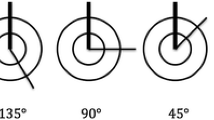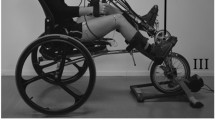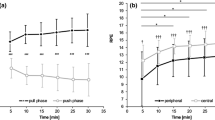Abstract
Purpose
The most commonly used propulsion method for handcycling is moving the arms symmetrically. Previous studies indicated that during outdoor handcycling symmetrical arm movements are more efficient. During locomotor movements, however, arm movements are performed asymmetrically in combination with leg movements. We questioned which combination of arm and leg movements is more efficient during combined arm and leg cycling for stationary use.
Methods
Twenty-five able-bodied adults performed eight submaximal tests of 6 min on a hybrid handcycle at three incremental gears during four different conditions (‘arms only’ and ‘arms & legs’ with arms symmetrical and asymmetrical). Oxygen uptake (VO2), heart rate (HR) and Borg score (Borg) were assessed.
Results
Increasing workload resulted in significant increases in VO2 (16 W: 13.0 ± 2.4 ml kg−1 min−1, 31 W: 14.5 ± 2.9, 49 W: 15.5 ± 2.8; p < 0.001) and Borg (16 W: 7.7 ± 1.7 points, 31 W: 8.6 ± 1.9, 49 W: 9.5 ± 1.9; p < 0.001). During ‘arms only’, no differences were found in exercise intensity between symmetrical and asymmetrical movements. Contrarily, during ‘arms & legs’, both VO2 (p < 0.001) and Borg (p = 0.001) were significantly lower for the asymmetrical (VO2: 13.8 ± 2.6 ml kg−1 min−1, Borg: 8.1 ± 1.6 points) compared to the symmetrical condition (VO2: 14.9 ± 2.8, Borg: 9.1 ± 2.0).
Conclusions
Results indicated that asymmetrical arm movements, especially in combination with leg movements, represented the most efficient condition on a stationary hybrid handcycle. The current results suggest that neural energy costs are lower when moving in the preferred (asymmetrical) coordination when no steering is required. These findings may have implications for stationary arm & leg cycling rehabilitation and tricycle adaptations in patients with spinal cord injury.


Similar content being viewed by others
Abbreviations
- ANOVA:
-
Analysis of variance
- HR:
-
Heart rate
- RER:
-
Respiratory exchange ratio
- SCI:
-
Spinal cord injury
- VO2 :
-
Oxygen uptake
References
Abel T, Vega S, Bleicher I, Platen P (2003) Handbiking: physiological responses to synchronous and asynchronous crank montage. Eur J Sport Sci 3:1–9. doi:10.1080/17461390300073401
Bafghi HA, de Haan A, Horstman A, van der Woude L (2008) Biophysical aspects of submaximal hand cycling. Int J Sports Med 29:630–638. doi:10.1055/s-2007-989416
Behrman AL, Harkema SJ (2000) Locomotor training after human spinal cord injury: a series of case studies. Phys Ther 80:688–700
Borg GA (1982) Psychophysical bases of perceived exertion. Med Sci Sports Exerc 14:377–381
Bougenot MP, Tordi N, Betik AC, Martin X, Le Foll D, Parratte B et al (2003) Effects of a wheelchair ergometer training programme on spinal cord-injured persons. Spinal Cord 41:451–456
Carroll TJ, Zehr EP, Collins DF (2005) Modulation of cutaneous reflexes in human upper limb muscles during arm cycling is independent of activity in the contralateral arm. Exp Brain Res 161:133–144. doi:10.1007/s00221-004-2050-7
Dallmeijer AJ, Ottjes L, de Waardt E, van der Woude LH (2004) A physiological comparison of synchronous and asynchronous hand cycling. Int J Sports Med 25:622–626. doi:10.1055/s-2004-817879
de Kam D, Rijken H, Manintveld T, Nienhuis B, Dietz V, Duysens J (2013) Arm movements can increase leg muscle activity during sub-maximal recumbent stepping in neurologically intact individuals. J Appl Physiol 115:34–42. doi:10.1152/japplphysiol.0 0510.2012
Dietz V (2002) Do human bipeds use quadrupedal coordination? Trends Neurosci 25:462–467
Dietz V (2003) Spinal cord pattern generators for locomotion. Clin Neurophysiol. 114:1379–1389 (pii: S1388245703001202)
Dietz V, Fouad K, Bastiaanse CM (2001) Neuronal coordination of arm and leg movements during human locomotion. Eur J Neurosci 14:1906–1914
Dominici N, Ivanenko YP, Cappellini G, d’Avella A, Mondi V, Cicchese M et al (2011) Locomotor primitives in newborn babies and their development. Science 334:997–999. doi:10.1126/science.1210617
Duysens J, Van de Crommert HW (1998) Neural control of locomotion; the central pattern generator from cats to humans. Gait Posture 7:131–141 pii: S0966636297000428
Faupin A, Gorce P, Meyer C (2011) Effects of type and mode of propulsion on hand-cycling biomechanics in nondisabled subjects. J Rehabil Res Dev 48:1049–1060
Ferris DP, Huang HJ, Kao PC (2006) Moving the arms to activate the legs. Exerc Sport Sci Rev 34:113–120 pii: 00003677-200607000-00005
Goosey-Tolfrey VL, Sindall P (2007) The effects of arm crank strategy on physiological responses and mechanical efficiency during submaximal exercise. J Sports Sci 25:453–460. doi:10.1080/02640410600702883
Heesterbeek PJC, Berkelmans HWA, Thijssen DHJ, van Kuppevelt HJM, Hopman MTE, Duysens J (2005) Increased physical fitness after 4-week training on a new hybrid FES-cycle in persons with spinal cord injury. Technol Disabil 17:103–110
Hiraoka K, Iwata A (2006) Cyclic modulation of H-reflex depression in ipsilateral and contralateral soleus muscles during rhythmic arm swing. Somatosens Mot Res 23:127–133. doi:10.1080/08990220600989650
Hiraoka K, Nagata A (1999) Modulation of the soleus H reflex with different velocities of passive movement of the arm. Electromyogr Clin Neurophysiol 39:21–26
Hol AT, Eng JJ, Miller WC, Sproule S, Krassioukov AV (2007) Reliability and validity of the six-minute arm test for the evaluation of cardiovascular fitness in people with spinal cord injury. Arch Phys Med Rehabil 88:489–495. doi:10.1016/j.apmr.2006.12.044
Hopman MT, van Teeffelen WM, Brouwer J, Houtman S, Binkhorst RA (1995) Physiological responses to asynchronous and synchronous arm-cranking exercise. Eur J Appl Physiol Occup Physiol. 72:111–114
Huang HJ, Ferris DP (2004) Neural coupling between upper and lower limbs during recumbent stepping. J Appl Physiol 97:1299–1308. doi:10.1152/japplphysiol.01350.2003
Jacobs PL (2009) Effects of resistance and endurance training in persons with paraplegia. Med Sci Sports Exerc 41:992–997. doi:10.1249/MSS.0b013e318191757f
Kao PC, Ferris DP (2005) The effect of movement frequency on interlimb coupling during recumbent stepping. Mot Control 9:144–163
Kawashima N, Nozaki D, Abe MO, Nakazawa K (2008) Shaping appropriate locomotive motor output through interlimb neural pathway within spinal cord in humans. J Neurophysiol 99:2946–2955. doi:10.1152/jn.00020.2008
Knikou M (2007) Neural coupling between the upper and lower limbs in humans. Neurosci Lett 416:138–143. doi:10.1016/j.neulet.2007.01.072
Mossberg K, Willman C, Topor MA, Crook H, Patak S (1999) Comparison of asynchronous versus synchronous arm crank ergometry. Spinal Cord 37:569–574
Valent LJ, Dallmeijer AJ, Houdijk H, Slootman HJ, Post MW, van der Woude LH (2008) Influence of hand cycling on physical capacity in the rehabilitation of persons with a spinal cord injury: a longitudinal cohort study. Arch Phys Med Rehabil 89:1016–1022. doi:10.1016/j.apmr.2007.10.034
Valent L, Dallmeijer A, Houdijk H, Slootman HJ, Janssen TW, Van Der Woude LHV (2010) Effects of hand cycle training on wheelchair capacity during clinical rehabilitation in persons with a spinal cord injury. Disabil Rehabil 32:2191–2200. doi:10.3109/09638288.2010.509461
van der Woude LH, Bosmans I, Bervoets B, Veeger HE (2000) Handcycling: different modes and gear ratios. J Med Eng Technol 24:242–249
van der Woude LH, Horstman A, Faas P, Mechielsen S, Bafghi HA, de Koning JJ (2008) Power output and metabolic cost of synchronous and asynchronous submaximal and peak level hand cycling on a motor driven treadmill in able-bodied male subjects. Med Eng Phys 30:574–580. doi:10.1016/j.medengphy.2007.06.006
Wannier T, Bastiaanse C, Colombo G, Dietz V (2001) Arm to leg coordination in humans during walking, creeping and swimming activities. Exp Brain Res 141:375–379
Zehr EP, Duysens J (2004) Regulation of arm and leg movement during human locomotion. Neuroscientist. 10:347–361. doi:10.1177/1073858404264680
Zehr EP, Hundza SR, Vasudevan EV (2009) The quadrupedal nature of human bipedal locomotion. Exerc Sport Sci Rev 37:102–108. doi:10.1097/JES.0b013e31819c2ed6
Acknowledgments
PM and JD were supported by a grant from ‘bijzonder onderzoeksfonds’ KU Leuven [grant number OT/08/034, PDMK/12/180], and by FWO (Fonds voor Wetenschappelijk Onderzoek Vlaanderen; scientific research funding Flanders) [grant number G.0901.11]. WH was supported by FWO [grant number G.0756.10]. R. Berkelmans is gratefully acknowledged for providing a special prototype of BerkelBike, allowing to study arm movements in different modes. We thank the physical therapists of the SCI unit at the Rehabilitation Centre Pellenberg (UZ Leuven) for their assistance and clinical expertise during the measurements. Special thanks are also due to Sarah Langendries and Celine Maisin for assistance with data acquisition and analysis. Furthermore, we would like to acknowledge J. Verellen and Prof. Y. Vanlandewijck for their support concerning the experimental setup.
Conflict of interest
The authors declare that they have no conflict of interest.
Author information
Authors and Affiliations
Corresponding author
Additional information
Communicated by Jean-René Lacour.
Rights and permissions
About this article
Cite this article
Meyns, P., Van de Walle, P., Hoogkamer, W. et al. Coordinating arms and legs on a hybrid rehabilitation tricycle: the metabolic benefit of asymmetrical compared to symmetrical arm movements. Eur J Appl Physiol 114, 743–750 (2014). https://doi.org/10.1007/s00421-013-2814-5
Received:
Accepted:
Published:
Issue Date:
DOI: https://doi.org/10.1007/s00421-013-2814-5




